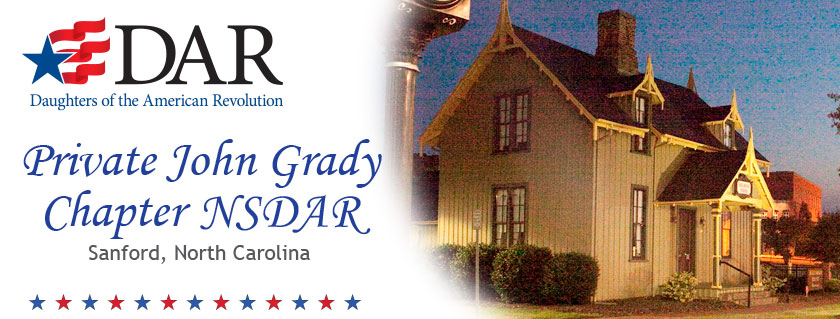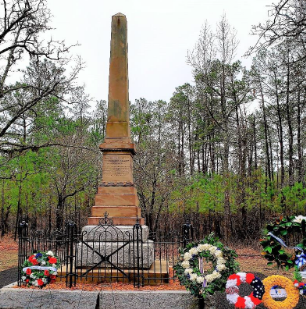
Photo Courtesy Jimmy Haire Photography
Private John Grady

Photo Courtesy Chapter Archives
Wreath-Laying Ceremony at Private John
Grady Monument
Imagine: It is five months before the Declaration of Independence is signed. The Crown has lost the rebellious colony of North Carolina.
The British make plans to subdue North Carolina:
- Send Lord Cornwallis with his seven regiments to meet Sir Henry Clinton at the port in Wilmington.
- Assemble a strategic Loyalist force from the Scottish Highlanders in North Carolina to join the British soldiers and subdue the rebellion.
Sixteen hundred North Carolinian Loyalists gather near Fayetteville to march to the port at Wilmington. They not only have to navigate through the swamps and rivers feeding into the ocean but also face a resourceful local opposition.
Local patriots organize and devise counter plans to thwart these 1600 Loyalists from reaching their rendezvous. At one point the Loyalists are forced to build their own bridge across the Black River. Eventually, on a cold wet winter night, the sly rebels are ready about 18 miles north of Wilmington. They pretend to have abandoned their camps in fear. Instead, they lie concealed, in waiting along the Moores Creek Bridge, where they then surprise the Loyalists.
At the end of the battle at Moores Creek Bridge, the Loyalists forces lose 850 of their 1600 men, as well as 1500 pounds of sterling, their artillery, weapons and pride. The rebels have only two wounded men out of their 1000 in the first Patriot victory of the American Revolution.
Our wounded patriot, Private John Grady, dies four days later. Does he know about the astonishing victory? We can only imagine. It is not recorded, but his brother is there with him and is unharmed in the battle. Private John Grady is the first North Carolinian to die for the American Revolution; our DAR Chapter honors his heroism in this stellar moment of history.
The National Park Service, Moores Creek Battlefield website reports, “Moores Creek is the site of the first Patriot victory in the American Revolution and the site of the last Scottish Highland broadsword charge. The victory ended British authority in the colony and stalled a full–scale British invasion of the South for nearly four years.”
The content contained herein does not necessarily represent the position of the NSDAR. Web hyperlinks to
non-DAR sites are not the responsibility of the NSDAR, the state organizations, or individual DAR chapters.